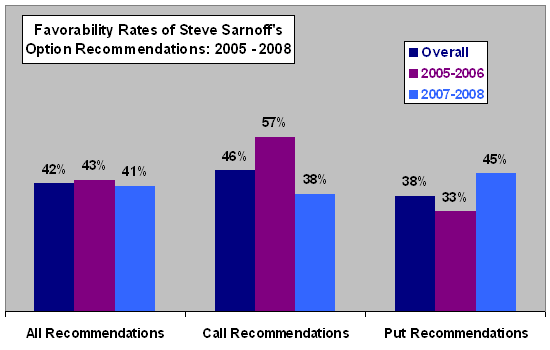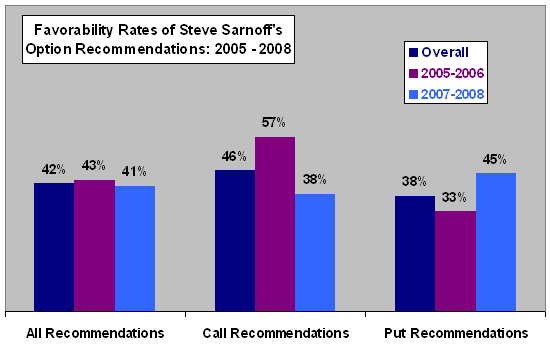A reader requested a review of the equity options trading advisory service offered as the “Options Hotline” via Agora Financial LLC. The “Options Hotline,” edited by Steve Sarnoff, presents to visitors a list of short-term “trades” with triple-digit gains and tells them: “If you are looking to make double- and triple-digit gains in a matter of months, weeks or even just days, you’ve come to the right place. Options are the best-kept secret on Wall Street, and mastering them can reap fantastic gains. Options Hotline can help you… Each week, editor Steve Sarnoff, painstakingly analyzes the markets to uncover the very best options with high gain potential.” Does this representation convey a realistic expectation? Does the “Options Hotline” offer value to subscribers? Using the self-reported recommended buys from the “Options Hotline” for 2005-2006 and for 2007-2008 and daily price data from Yahoo!Finance for the underlying securities from the day after recommendation dates through specified option expiration dates, we conclude that:
The note accompanying the list of extremely successful trades at the “Options Hotline” states:
“Gains are based on all triggered picks, assuming exit point at peak option value. Percent gain represents the percentage change at the subsequent high value, from the trigger price… Profit calculations do not factor in commission and taxes.” [Underlining added.]
Said plainly, reliably capturing the gains presented as examples requires perfect hindsight looking backward from the option expiration dates to the option purchase dates. Just about any trading system could produce fantastic gains operating in perfect hindsight. The probability of systematically achieving such gains is vanishingly small. The expectation conveyed by this assumption is not realistic. The examples presented at “Options Hotline” seem designed more to mislead and capture naive prospects than to educate visitors about speculating with options.
To dig deeper into the question of whether Steve Sarnoff’s “Options Hotline” recommendations offer value to subscribers, we analyze the two self-reported samples of recommended options trades. Since we do not have options price histories, we look at the price ranges of the underlying securities during the potential options holding intervals to determine whether Steve Sarnoff systematically recommends the “more favorable” side of options trades. In other words, when he recommends buying call (put) options, do the underlying securities show greater upside (downside) movement in the intervals between purchase dates and specified option expiration dates? This methodology is favorable to Steve Sarnoff in that it ignores the time values of options, which work steadily against long options positions. In performing the analysis, we:
- Omit all recommendations designated as”DID NOT TRIGGER”.
- Eliminate the slight overlap in trades between the two source lists by discarding duplicates.
- As the opening price of the underlying security during which the options position may be active, use the unadjusted close on the next trading day after the recommendation date.
- Define the subsequent exploitable range of the underlying security using the lowest daily low and the highest daily high from the next day through the specified options expiration date .
- Used QuoteMedia rather than Yahoo!Finance to obtain data for two trades involving Merrill Lynch stock options and one trade involving Wachovia Bank stock options because the historical stock quote data for these merged companies is not available via Yahoo!Finance.
The resulting sample consists of 141 options trade recommendations over the period 2005-2008, as listed for reference in the table at the end of this analysis. Cells in the third column are shaded light green (pink) if the recommendation is to purchase calls (puts). At the far right of each row is a red plus or minus sign indicating whether the exploitable range of the underlying security during the potential life of the option position favored the prior selection of a call or put option. For example, a maximum downside much larger in magnitude than the maximum upside tends to favor the prior purchase of a put option.
The following chart summarizes percentages of recommendations that earn plus signs in the table (favorability rates) for all recommendations, for recommendations to purchase call options and for recommendations to purchase put options. It also shows how these favorability rates differ for the first half (2005-2006) and the second half (2007-2008) of the sample. Results suggest that:
- Steve Sarnoff recommends the more favorable side of the options trade only 42% of the time, with this favorability rate fairly consistent across subperiods.
- Favorability rates for call and put purchase recommendations appear to vary with market conditions, with calls (puts) having the higher favorability rate during the 2005-2006 (2007-2008) subperiod.

For another perspective on the quality of Steve Sarnoff’s advice, the next chart compares the average maximum upsides and downsides from the day after recommendation dates through option expiration dates for securities underlying all recommendations, recommendations to purchase call options and recommendations to purchase put options. The chart shows that:
- On average, the upside extremes for underlying securities are larger than the downside extremes during the intervals that Steve Sarnoff’s recommendations are potentially active, suggesting that recommendations should have tilted toward calls. 51% of Steve Sarnoff’s recommendations are calls.
- For Steve Sarnoff’s call recommendations, average upside and downside extremes are equal. In other words, they have no edge based on this simple volatility measure.
- For Steve Sarnoff’s put recommendations, the average upside extreme is larger than the average downside extreme. In other words, these plays appear better suited for call options than put options, casting doubt on Steve Sarnoff’s ability to predict the price action of individual stocks.

In summary, evidence from simple tests does not support a belief that Steve Sarnoff’s option trading recommendations have value. The “Options Hotline” promotional verbiage based on perfect hindsight seems intended more to deceive than to inform.
Individuals evaluating trading advisory services may want to require results from reasonably verified actual trading by the offeror rather than accept results from hypothetical trading based on unrealistically optimistic assumptions.
For assessments of the forecasting accuracy of other investing experts, see Guru Grades. See also the Equity Options category for formal research on speculating and hedging with options. Most of this research indicates that odds are stacked against long calls and puts and for short calls and (especially) puts.
